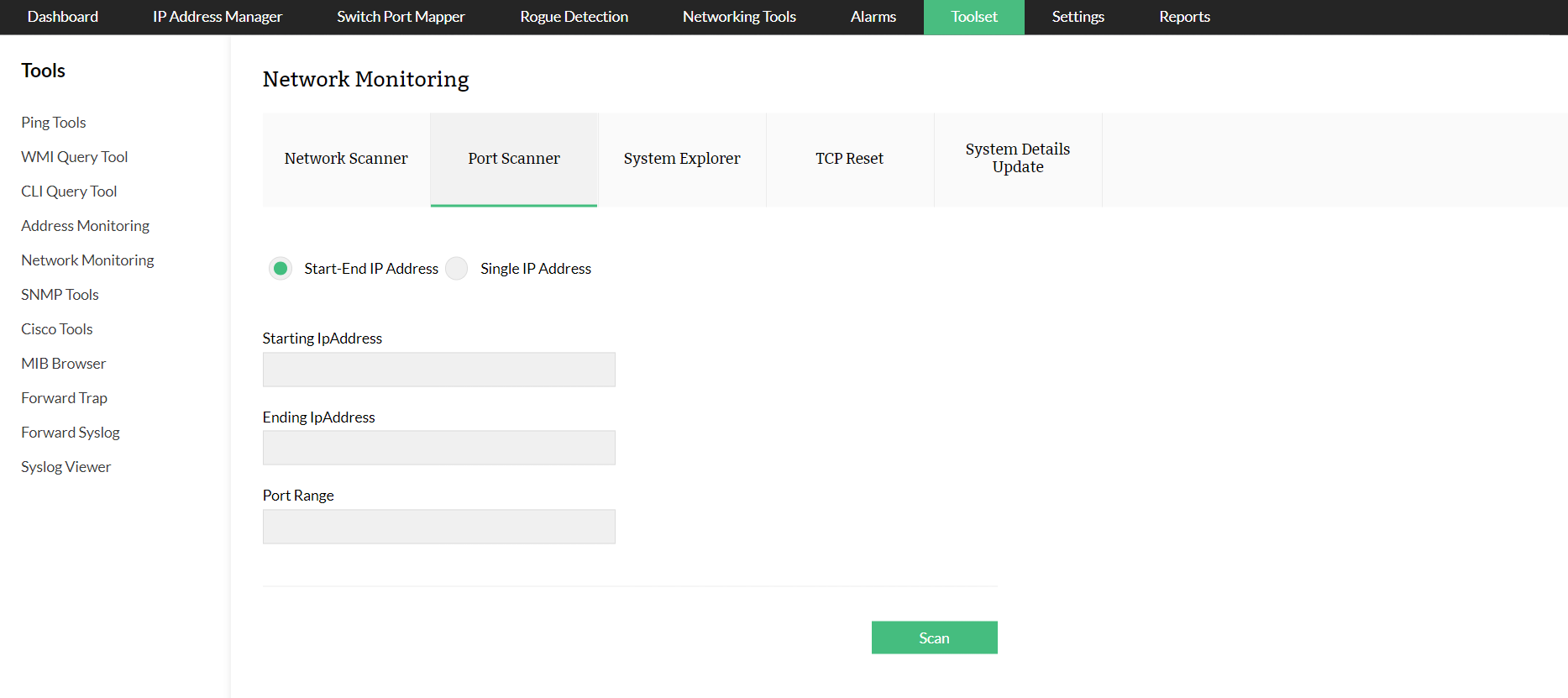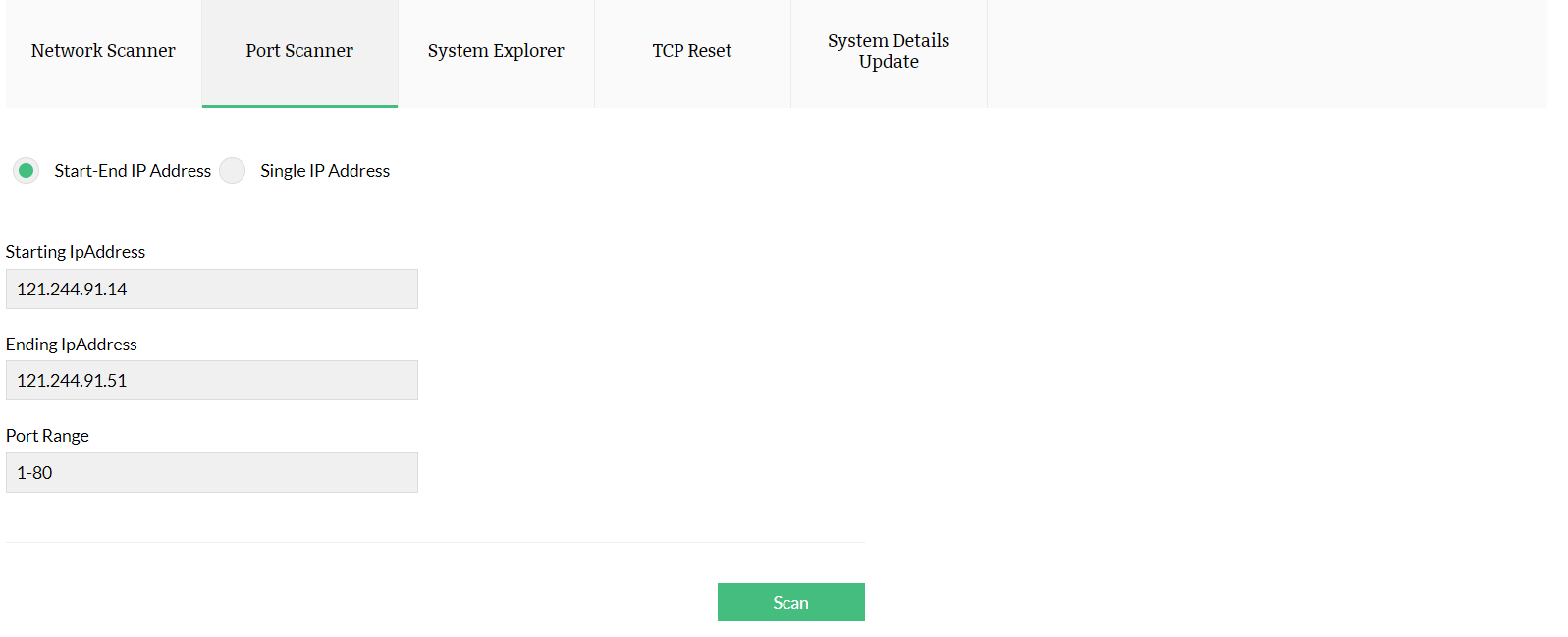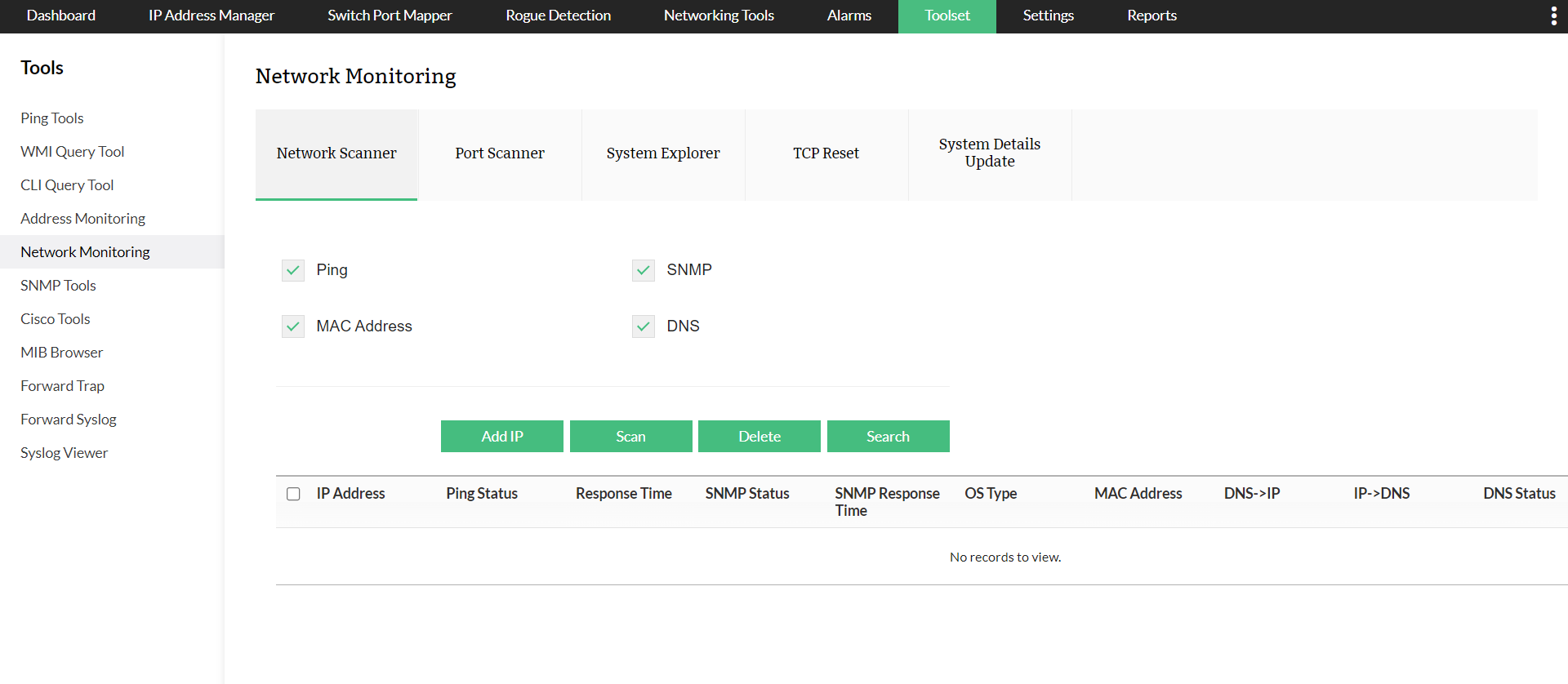Open port scanning with OpUtils
The rise in network attacks over the years has caused IT administrators to take network security practices more seriously. A port scanning attack is a common type of network attack used by hackers to infiltrate your network using vulnerable open ports. However, port scanning can also be an effective practice when leveraged by network adminstrators. It helps them perform network reconnaissance and identify malicious services running, enabling them to block unwanted traffic and secure network ports. Open port scanning is the process of identifying and analyzing open ports on a network using open port scanner tools.
In this page, we look into,
Challenges in port scanning: The need for an integrated open port scanner
There are plenty of options available when it comes to choosing an open port scanner, be it a stand-alone tool, an online tool, or an integrated tool. However, using traditional stand-alone or online, open-source port scanner tools to manage and monitor millions of ports in your dynamic IT workspace is challenging and unfeasible. The following are the drawbacks of not having an integrated open port scanner:
Scalability:
As devices keep being added to your enterprise network, it can be hard to manage and monitor all the ports associated with those devices without a dynamic port scanning tool. Conventional open-source, stand-alone or online port scanning tools offer limited scan range and capabilities that do not scale with your growing network.
Centralization:
Enterprise networks are distributed across cross-subnets, remote sites, and multiple data centers. Unlike stand-alone or online open port scanners, integrated open port scanner tools can give you holistic visibility into your entire network by scanning ports across your network.
In-depth drill down and device inspection:
Using stand-alone or online open port scanner tools can provide you with insights on the services running on particular devices. However, they do not offer insights on the processes or hardware impact of the services running. This calls for a centralized, comprehensive network tool set that can help network administrators inspect, monitor, and diagnose several networking aspects of the inspected port. This increases your team's efficiency, and is less time-consuming.
Network reconnaissance security:
Collecting and analyzing data from port scanners, network scanners, and IP scanners can be tedious without centralized tools or tracking. Correlating data from different sources, i.e., stand-alone or point tools, can lead to errors which might impact the effectiveness of the network reconnaissance carried out.
Merging open port scanning tools with an IP address management (IPAM) inventory can give you more control and visibility over your network by correlating IPAM and port scanning data.
OpUtils' port scanner tool correlates data collected from the IPAM module and can help you get a complete overview of your organization's network. Here's how:
Features that make OpUtils' open port scanner tool stand out
With OpUtils, you can monitor a range of ports and the services running on them right from your centralized port scanning console. OpUtils' port scanner tool is built to tackle the scale and challenges involved in scanning ports in modern IT infrastructures and also offers other useful tools for pinging and querying your open ports. This provides:
Get visibility into the status of your ports and services running on them:
OpUtils' open port scanner tool will help you identify open, closed, and filtered ports.
| Open |
A port is open if its port number (TCP or UDP) is configured to accept data packets. |
| Closed |
A port is closed if its application or service is not actively listening. |
Discover and track multiple ports and services across a range of IP addresses with ease. OpUtils' open port scanner tool allows you to monitor open ports in real time. Track all the services running on your ports and turn them off when necessary. With OpUtils' open port scanner, you can also check if your open ports are working efficiently by monitoring their response time.

You can scan a single port or a range of ports together with OpUtils' open port scanner.
How to scan a single open port:

To scan an open port, enter your IP address and port range, and click Scan.
How to scan multiple open ports:

To scan multiple ports together, enter your IP address or range, and enter your port range (this can be done separating port numbers with a hyphen). You can also enter multiple port numbers by separating them with a comma. When you're ready, click Scan.
Test your open ports to ensure port availability and security:
Open ports must be tested to ensure that they are listening and not posing a security risk.
After you discover your ports in the OpUtils console and scan them, OpUtils will give you a consolidated, tabular view of all the ports that are listening, filtered, and not listening in real time. With the help of this feature, you can monitor your ports to ensure port availability constantly.
Diagnose your complex network infrastructure with ease:
OpUtils provides you a network scanner tool along with an open port scanner to diagnose and detect all the active hosts in your organization's network.
Obtain maximum visibility into your network node's IP addresses, ping statuses, response times, SNMP statuses, SNMP response times, OS types, MAC addresses, DNS forward lookups, DNS reverse lookups, and DNS status
Perform TCP reset operations with OpUtils and close all suspicious connections. Keep track of all the open ports that are actively listening, their IP addresses, and the port numbers of servers and clients. Organize your ports by deleting the ones that you don't need.
OpUtils also offers a management information base browser for SNMP devices, which provides valuable insight into your network by enabling you to query SNMP-enabled devices. Get visibility into SNMP traps, syslog messages, and Windows event logs with the help of OpUtils' syslog viewer.

All networking tool sets in a single dashboard:
Manage all your networking tools without the hassle of switching between different tools.

FAQs: More on open port scanning
What are open ports?
+
Open ports are the ports in which their TCP or UDP port numbers are configured to accept incoming network packets. To give you a perfect analogy of an open port, it's like a doorway to your house: You can either accept or reject guests through the doorway. A port is closed if it rejects connections or ignores all network packets.
Ports are essential for sending and receiving information across any network. Services like HTTP or FTP require system ports to be open to perform TCP handshakes. It is often interpreted that open ports are vulnerable but this is not always true. Just because a port is open does not necessarily mean that it can be accessed. There needs to be a service application listening on an open port, accepting and acknowledging network packets. As long as there are no services running on an open port, incoming packets will be declined. Open ports can be closed or filtered with the help of a firewall.
What are the types of open ports?
+
Port numbers range from 0 to 65,535. These port numbers are classified into three types based on their activity:
- Well-known ports
- Registered ports
- Dynamic ports
Well-known ports: Port numbers ranging from 0 to 1,023 (also known as well-known ports) are reserved for common TCP and IP applications and are usually left open for communication. They are used by client applications to locate the application processes running on the host server.
Registered ports: Port numbers ranging from 1,024 to 49,151 are registered and closed. Vendors use these ports for their own server applications.
Dynamic ports: Port numbers ranging from 49,152 to 65,535 are known as dynamic ports. They are used for temporary data transmission and are not registered. These ports are also called private ports.
What are the most frequently used open ports?
+
| Port number |
Protocol |
Description |
| 80 |
Hyper Text Transfer Protocol (HTTP) |
Port 80 is used for managing HTTP requests. They are vulnerable to DDoS attacks and SQL injections (placing malicious code in SQL statements through webpage inputs). |
| 443 |
Hyper Text Transfer Protocol Secure(HTTP) |
Port 443 is just a classified version of port 80. This port uses TLS to encrypt and digitally sign HTTP requests and responses. |
| 20, 21 |
File Transfer Protocol (FTP) |
Port 20 and 21 are used for data transmission between a client and a server. FTP ports can be exploited using cross-site scripting, anonymous authentication, and directory traversal attacks. |
| 22 |
Secure Shell Protocol (SSH) |
Port 22 runs SSH, which is a data tunneling protocol where the data packets are encapsulated within other data packets. |
| 53 |
Domain Name System (DNS) |
Port 53 is used for matching computer-readable IP addresses to human-readable domain server names. Hackers use redirection attacks or DNS hijacking to exploit port 53. |
| 23 |
Telnet Protocol |
The Telnet Protocol allows clients to connect to remote hosts and provides a collaborative, text-based connection between the client and the server. Port 23 is vulnerable to DDoS and man-in-the-middle attacks as the information sent between the clients and the servers are not encrypted. |
| 25 |
Simple Mail Transfer Protocol (SMTP) |
Port 25 is responsible for sending and receiving emails. Misconfigurations in SMTP can lead to spoofing and spamming attacks. |
| 445 |
Server Message Block (SMB) |
SMB is client-server file transmission protocol. Port 445 communicates using NetBios (a layer 5 protocol). It's used for device communication in a Windows network. |
Common vulnerabilities found in open ports:
+
The most common way hackers break into your system is through open ports that are vulnerable. But, to send and receive data within a network, certain ports must always be open. Here is a list of vulnerabilities that hackers can detect in open ports:
- Unpatched services used in an open port
- Misconfigurations in cloud apps or firewalls
- Poor network security rules
Unpatched services used in an open port: It is important to always update all the application services running on your ports. Unpatched application services can make your open ports vulnerable to port scanning attacks.
Misconfigurations in the cloud or firewall: Firewall or cloud misconfigurations, such as unrestricted inbound ports or unrestricted outbound ports, can expose systems to open port vulnerabilities. It is unnecessary to provide outbound access to RDP or SSH connections, as this would open the door to network scanning and data theft.
Insufficient rules for network security: Without proper network security, your organization's network can be easily hacked by perpetrators using vulnerable open ports. Here are some network security issues that need to be addressed:
-
Not validating the devices that enter your network: It's critical to keep track of all the devices present in your organization's network and restrict access to rogue devices as they may try break into systems through open ports.
-
Not monitoring live traffic and inactive logging: Monitoring all your outbound and inbound traffic is vital. This will help you block unwanted network packets being sent to your open ports. Actively logging all events occurring on your open ports is also a best practice.
-
Allowing unwanted ICMP requests: The Internet Control Message Protocol (ICMP) is responsible for sending network device errors. Using this, hackers can pinpoint a server and send it multiple ICMP requests to make the host server crash. This is also known as a DDoS attack. To avoid this, it's better to close all ICMP ports when not in use.
Why do you have to scan your open ports regularly?
+
There are two main reasons why you need to monitor your open ports regularly:
- For maximum efficiency
- To prevent perpetrators from abusing your devices
For maximum efficiency: Monitoring all the services running on your device, shutting down unwanted services, and closing ports when not in use will improve your organization's network efficiency. It is a best practice to assign the ports yourself rather than having a default port setup as it will enable you to be aware of the services running on each port. This can be tedious if your organization has a lot of devices. The best way to resolve this is to use a port scanning tool like OpUtils. This will not only save you a lot of time but also boost your organization's efficiency.
To prevent perpetrators from abusing your devices: There are lot of open-source port scanning tools hackers use to locate vulnerable open ports. Monitoring and keeping track of your ports and the services running on them can keep you safe from these hackers and prevent you from leaking sensitive corporate information.




